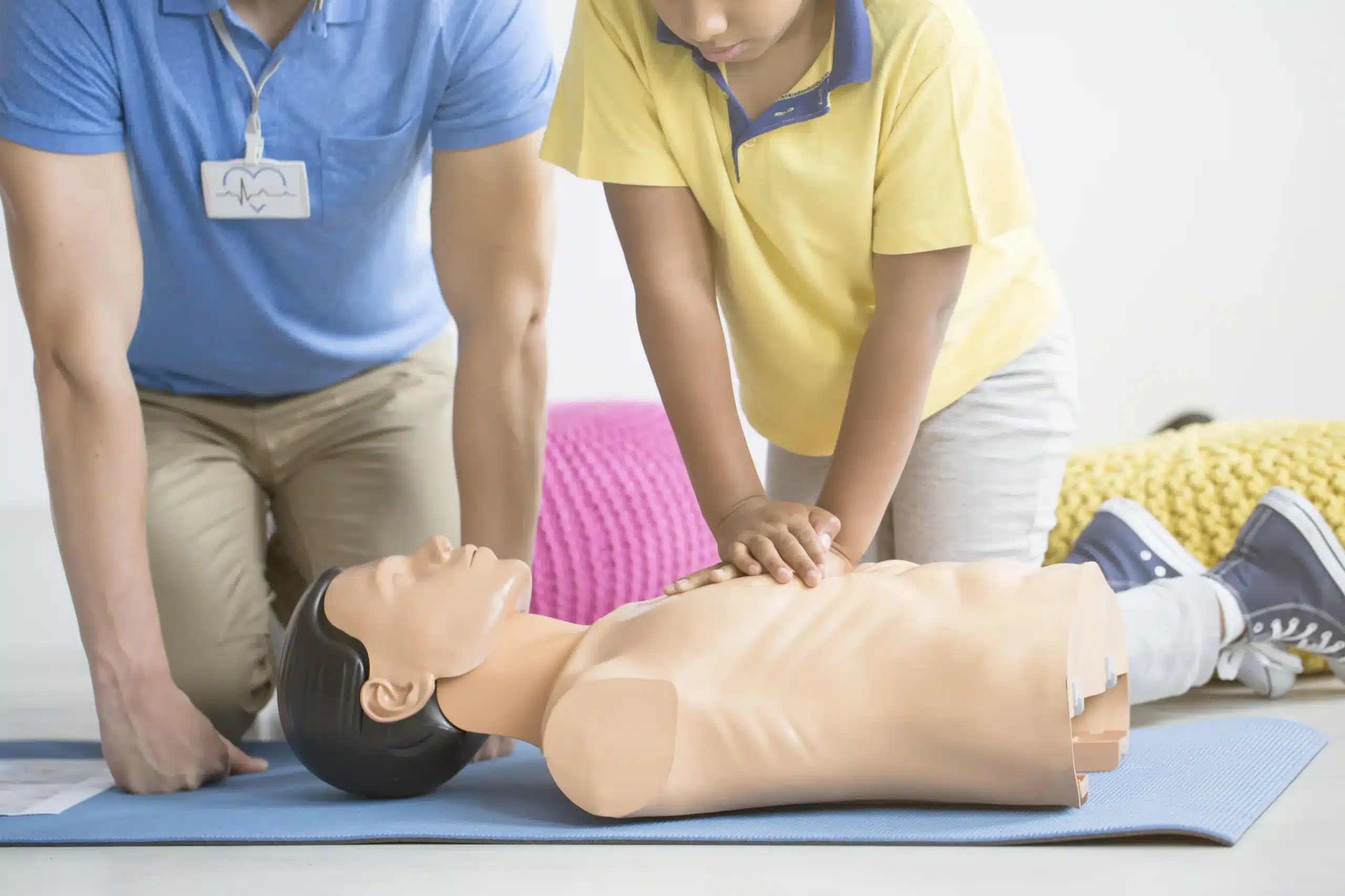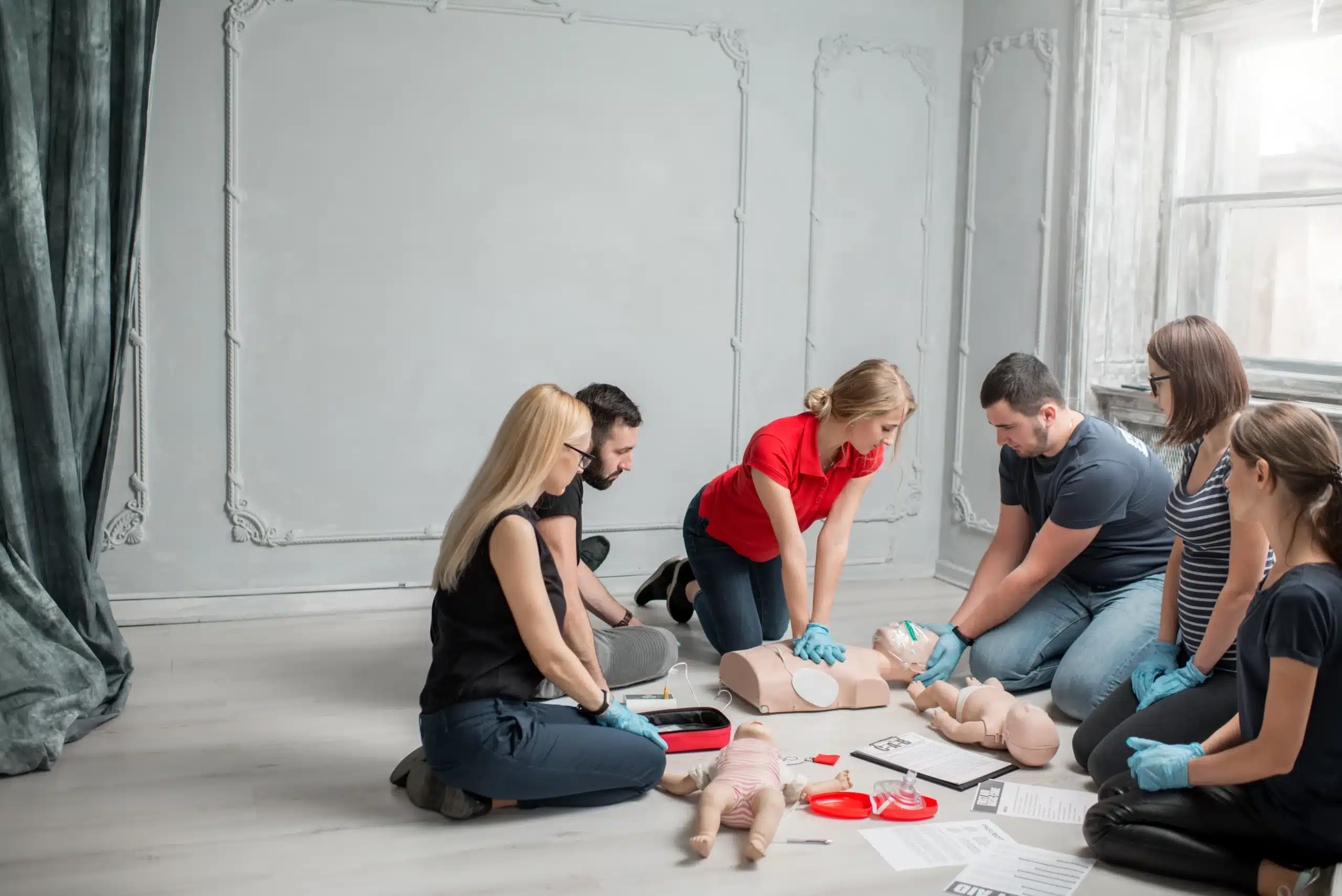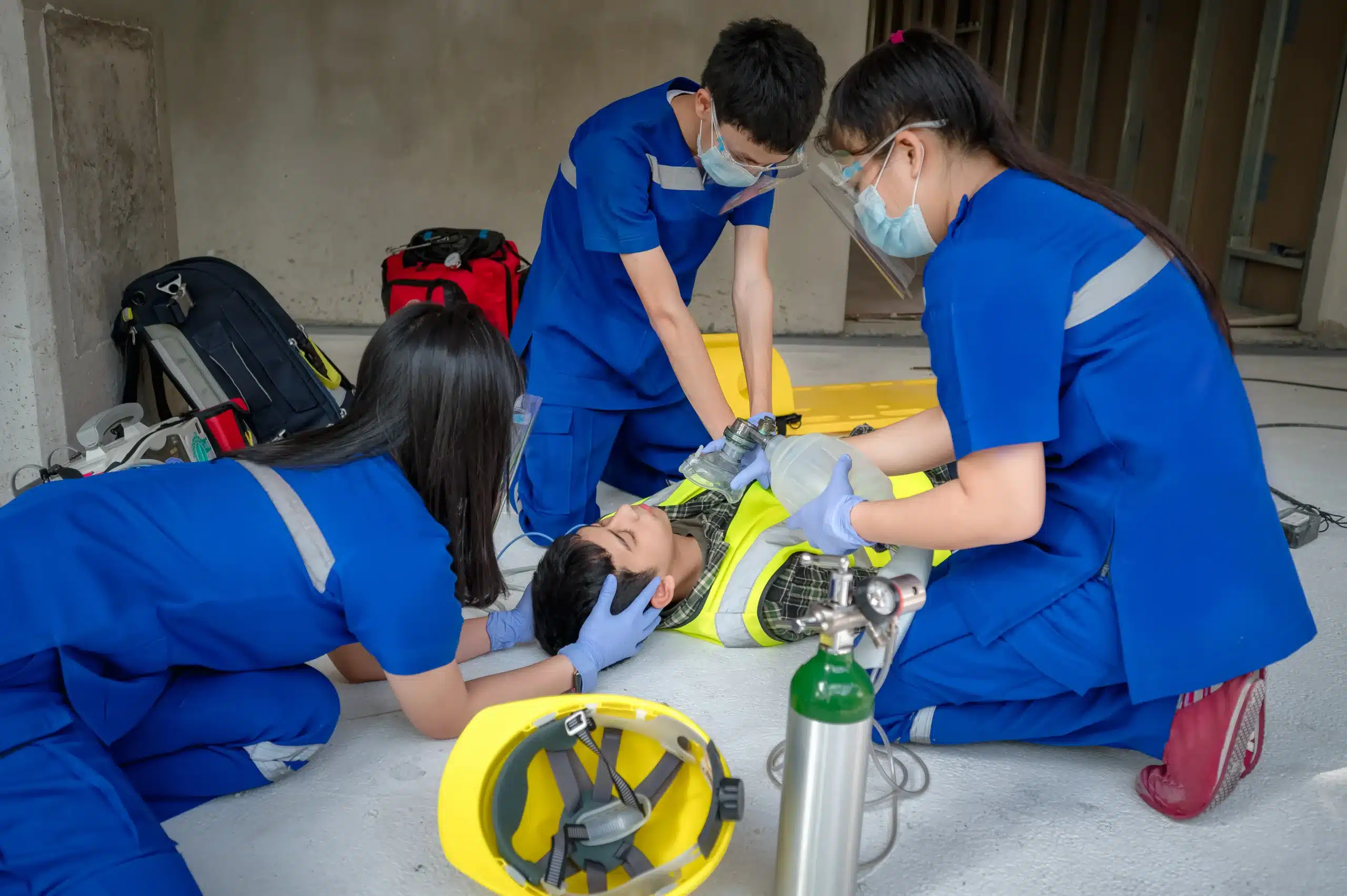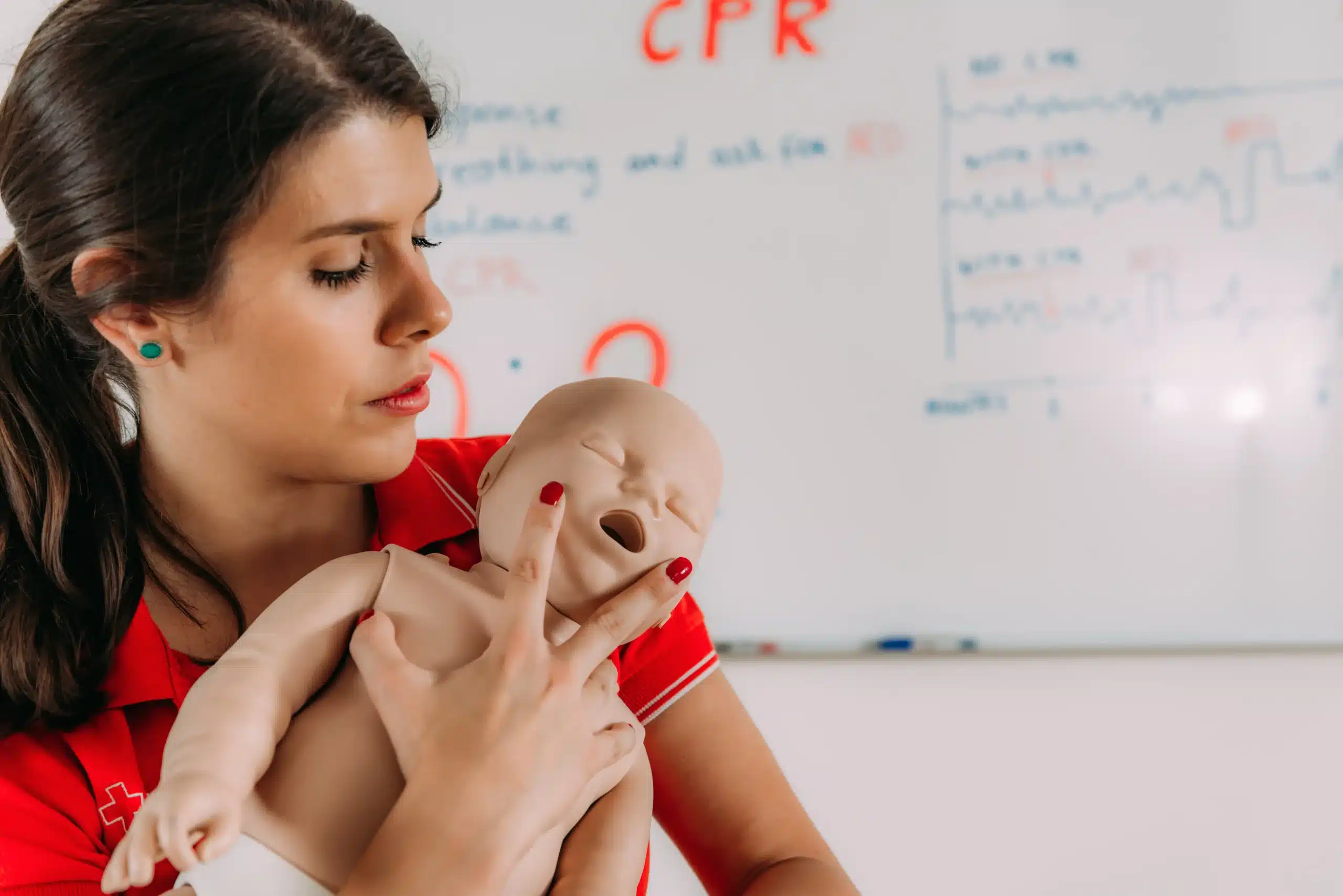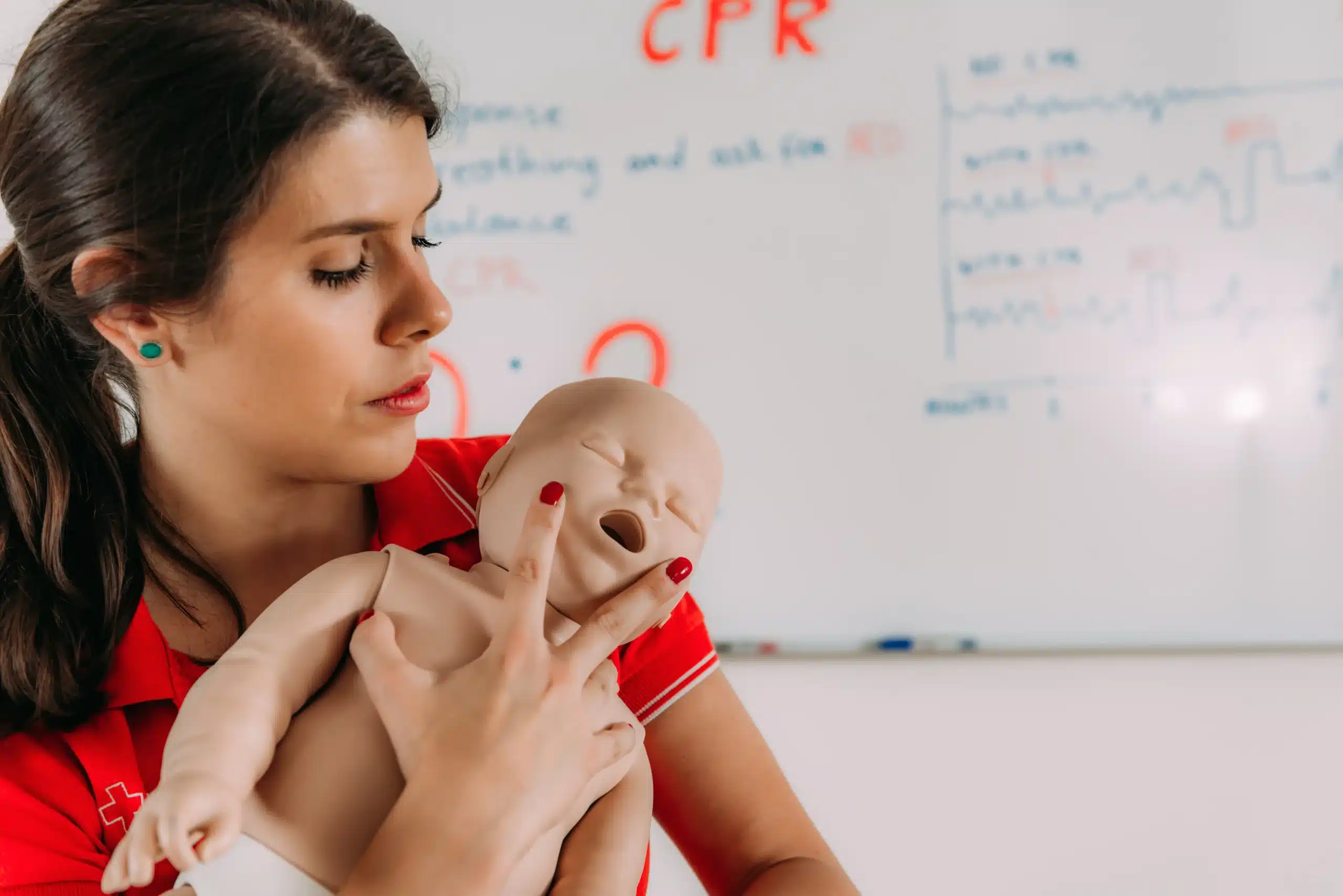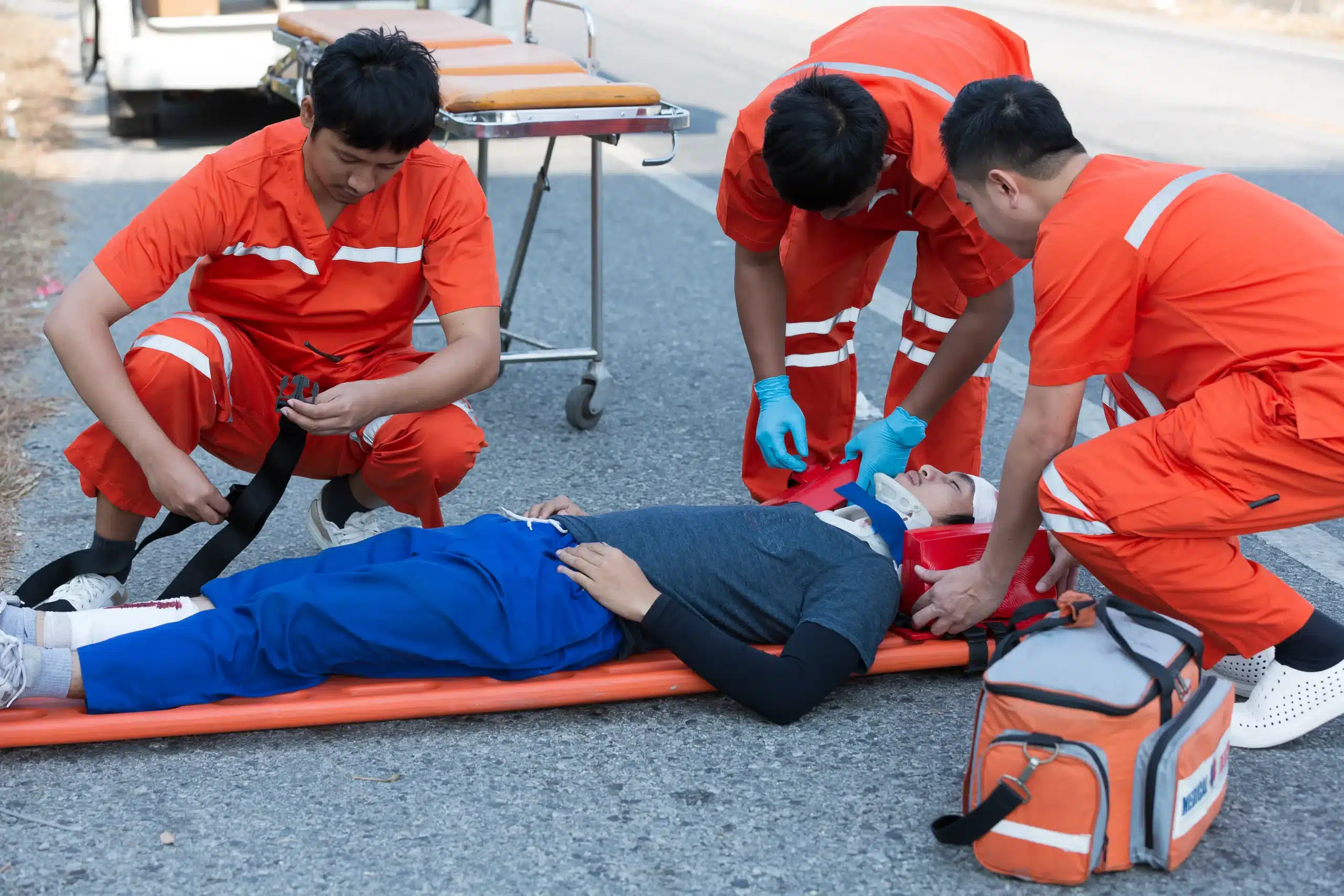Life with kids is an adventure, and sometimes, that adventure includes unexpected bumps and bruises—or worse. Knowing how to respond quickly and effectively in a medical emergency can make all the difference. That’s why pediatric CPR and first-aid training in Carmichael is so vital for parents, caregivers, and anyone working with children. This article explores the essential skills covered in these courses, including CPR techniques adapted for infants and children, how to handle common childhood emergencies, and injury prevention strategies. We’ll also discuss finding the right course in Carmichael, certification options, and the importance of keeping your skills up-to-date. Empower yourself with the knowledge and confidence to protect the children you love.
Key Takeaways
- Pediatric CPR and first aid are crucial for caregivers: These skills empower you to confidently handle childhood emergencies like choking, allergic reactions, and injuries. If you’re a childcare provider, ensure your training aligns with state licensing requirements.
- Local training providers offer personalized experiences: Carmichael-based providers often offer convenient locations, experienced instructors familiar with California regulations, and competitive pricing. Choose a course that fits your schedule and learning style.
- Regularly refresh your skills: CPR and first-aid guidelines change, so staying current is essential. Recertification courses help you maintain your skills and confidence so you’re always prepared.
What is Pediatric CPR and First-Aid?
Pediatric CPR and first-aid training gives caregivers the skills to respond to emergencies involving infants and children. It covers a range of topics, from CPR and choking relief to dealing with common childhood injuries and illnesses. This specialized training focuses on the unique physiological differences between children and adults, ensuring you’re prepared to act quickly and effectively in a crisis.
Why It Matters for Parents and Caregivers
For parents, grandparents, babysitters, and anyone regularly caring for children, pediatric first-aid and CPR training is invaluable. Knowing how to respond to a medical emergency can make a critical difference. It empowers you to confidently handle situations like choking, allergic reactions, burns, and other unexpected events. Plus, many childcare licensing agencies require this specialized training, making it essential for those working with children. Having these skills helps protect the children in your care and provides you with peace of mind.
Key Differences from Adult CPR
While the basic principles of CPR remain consistent, there are crucial differences between adult and pediatric CPR. These differences stem from variations in anatomy and physiology. For example, infant CPR often involves using two fingers for chest compressions, while adult CPR uses two hands. The compression-to-breath ratio can also vary. Pediatric first-aid training also addresses common childhood illnesses and injuries that you wouldn’t typically encounter with adults. Understanding these distinctions is vital for providing safe and effective care. A specialized pediatric first-aid and CPR course will cover these differences in detail, ensuring you’re well-prepared.
Find Pediatric CPR & First-Aid Training in Carmichael
Finding the right pediatric CPR and first-aid training is crucial for parents, caregivers, and professionals working with children. Carmichael offers several options to fit your needs and schedule. Here are a few providers to consider:
Carmichael CPR Classes by Safety Training Seminars
Safety Training Seminars offers various American Heart Association (AHA) courses, including BLS, ACLS, PALS, CPR, and first-aid. They prioritize high-quality training and offer classes daily throughout Carmichael and surrounding areas. Visit their website for schedules and course details. Their convenient locations and commitment to customer service make them a popular choice.
In-Home CPR
If flexibility is a priority, consider In-Home CPR. They bring the training to your home or office seven days a week, including evenings. This personalized approach is especially helpful for busy parents or groups. Learn more about their Carmichael CPR classes.
Professional CPR
Professional CPR provides AHA-certified training in CPR, BLS, AED, and first aid in Carmichael and other locations. This makes them a convenient option if you’re looking for training in multiple areas. See their website for course offerings and schedules.
Safety Training Pros
Specifically for childcare providers in California, Safety Training Pros offers pediatric first aid and CPR training that meets Title 22 requirements. This specialized training ensures compliance with state regulations and provides the skills needed to handle emergencies in childcare settings. Explore their childcare courses.
American Heart Association Courses
The American Heart Association sets the standard for resuscitation science and training. While they don’t offer classes directly, their website is a valuable resource for learning about the latest guidelines and finding certified training centers. Familiarize yourself with the AHA’s recommendations as you research providers.
What Will You Learn in a Pediatric CPR & First-Aid Course?
Pediatric CPR and first-aid courses give you the skills to respond to emergencies involving infants and children. These courses cover many topics, from CPR techniques and first-aid basics to injury prevention and using AEDs. Let’s look at what you can expect to learn.
CPR for Infants and Children
This section focuses on CPR techniques adapted for infants and children. You’ll learn how to assess a child’s responsiveness, perform chest compressions and rescue breaths, and clear an obstructed airway. The techniques differ from adult CPR because of the smaller size and delicate physiology of young children. A pediatric CPR course typically includes plenty of time for hands-on practice and testing, so you feel confident performing these life-saving skills.
Common Pediatric Emergencies
Beyond CPR, the course addresses common pediatric emergencies like choking, allergic reactions, burns, and wounds. You’ll learn to recognize the signs and symptoms of these emergencies and provide appropriate first aid until professional help arrives. Knowing how to handle these situations can make a real difference. The American Red Cross offers a combined Adult and Pediatric First Aid/CPR/AED course covering various emergencies.
Prevent Injuries
A significant part of pediatric first-aid training emphasizes injury prevention. You’ll learn about common childhood hazards and how to create safer environments. This proactive approach can help minimize the risk of accidents and injuries. First-aid training is especially helpful for childcare providers, giving them the tools to create safer environments and respond effectively to emergencies.
Use AEDs on Children
The course also covers the safe and effective use of automated external defibrillators (AEDs) on children. You’ll learn how to operate an AED, recognize when it’s appropriate, and adapt the procedure for children of different ages. The American Heart Association offers Heartsaver Pediatric First Aid CPR AED courses that include training on AED usage for children. Knowing how to use an AED can significantly increase a child’s chances of survival during a cardiac emergency.
Certifications & Validity
Choosing the right CPR and first-aid certification course is crucial, especially when dealing with young children. Understanding what certifications are offered and their validity ensures you’re prepared for emergencies. This section clarifies these key aspects of pediatric CPR and first-aid training in Carmichael.
American Heart Association Certifications
Carmichael CPR Classes focuses on American Heart Association (AHA) certifications. The AHA leads resuscitation science, education, and training, and publishes the official Guidelines for CPR and ECC. This makes an AHA certification from Carmichael CPR Classes widely recognized and respected, signifying training based on the latest research and best practices. Learn more about the AHA’s commitment to CPR and first-aid training on their website.
How Long Does Certification Last? How Do I Renew?
Your AHA certification through Carmichael CPR Classes is valid for two years, aligning with industry standards and ensuring your skills and knowledge remain current. After two years, you’ll need a recertification course to renew your credentials and stay updated on any CPR guideline changes. Carmichael CPR Classes offers various courses and information on recertification to easily maintain your certification.
Meeting California Title 22 Requirements
For childcare providers in California, meeting Title 22 requirements is essential for licensing. Carmichael CPR Classes offers pediatric first aid, CPR, and AED certification classes that satisfy these EMSA requirements. This allows you to fulfill licensing obligations while gaining skills to provide a safe and healthy environment for children in your care, offering peace of mind for you and the families you serve.
Compare Carmichael Course Offerings
Choosing the right pediatric CPR and first-aid class depends on your specific needs. Carmichael offers a variety of courses, each with a unique curriculum and format. Use this section to compare your options and find the best fit.
Curriculum Focus and Depth
Some courses focus specifically on CPR and AED use for infants and children, while others include a broader range of first-aid topics. For example, providers teaching courses that meet California’s EMSA requirements for childcare providers cover pediatric-specific emergencies and injuries relevant to daycare settings. If you’re a parent, a more general pediatric first-aid course might be sufficient. Consider your specific needs when selecting a class.
Course Length and Format
Course length can vary from a few hours for basic CPR to a full day for more comprehensive training. An AHA Pediatric CPR/AED and First Aid class typically runs about eight hours, allowing ample time for hands-on practice and assessment. Shorter, more focused courses are also available if you need a refresher or have limited time. Consider, too, whether you prefer in-person or blended learning formats.
Teaching Methods and Materials
Most established providers, like those offering American Heart Association courses, use standardized, science-based curricula. This ensures consistency in the skills taught, regardless of where you take the class. Look for courses that use a combination of lecture, demonstration, and hands-on practice for the best learning experience.
Hands-On Practice
The opportunity to practice skills on mannequins and with other students is crucial for developing confidence and competence. A good course will provide ample time for hands-on practice of essential skills, such as CPR compressions, rescue breaths, and using an AED on infants and children. Comprehensive courses often cover a wider range of scenarios, including choking, burns, and allergic reactions.
Bilingual Options
If your first language isn’t English, check if bilingual instruction is available. Some providers, like Professional CPR, offer courses in Spanish, making it easier to understand the material and ask questions. This can be particularly helpful if you’re learning these life-saving skills for the first time.
Costs & Value
Knowing the price ranges for CPR and first-aid training can help you budget and compare options. While cost is a factor, the value of these lifesaving skills is immeasurable.
Course Prices
CPR and first-aid course prices vary depending on the provider, the type of certification (e.g., basic CPR, BLS for healthcare providers), and whether you choose online or in-person training. Basic CPR and first-aid courses can start as low as $35 at some community centers, like the Del Puerto Health Care District. More specialized courses, such as the Heartsaver® Pediatric First Aid CPR AED course, can cost around $120. Always check with your chosen provider, like Carmichael CPR Classes, for the most up-to-date pricing.
Group Discounts and Packages
Many training providers offer discounts for group bookings, making it a cost-effective choice for workplaces, families, or groups of friends. Safety Training Pros, for example, offers this option. Some providers also offer package deals that combine certifications, such as CPR, first-aid, and AED training, often at a lower overall cost. Inquire with specific providers, including Carmichael CPR Classes, about group discounts and available packages.
Online vs. In-Person Training Costs
Online CPR certification courses, like those from the National CPR Foundation, are generally less expensive than in-person classes, often starting as low as $12.95. They offer a convenient way to learn the basics. However, online courses typically only cover the cognitive portion of the training. For the hands-on practice necessary to build confidence and proficiency, the American Heart Association recommends a blended learning approach, combining online learning with in-person skills sessions. Their Heartsaver® Pediatric First Aid CPR AED blended learning course is one example.
Long-Term Value
The true value of CPR and first-aid training goes beyond the course price. These skills empower you to respond confidently during emergencies. For childcare providers, training is essential for maintaining a safe environment, as highlighted by ChildCareEd. MyCPR NOW emphasizes how first-aid training equips childcare workers to handle emergencies effectively, potentially lessening the severity of injuries. The peace of mind and ability to act quickly are invaluable, lifelong benefits.
Benefits for Parents & Childcare Providers
Knowing how to respond to a medical emergency can make all the difference, especially when it comes to children. Pediatric CPR and first-aid training equips parents and childcare providers with the skills to handle emergencies confidently and effectively. Let’s explore some key benefits:
Prepare for Emergencies with Confidence
Emergencies can happen anytime, anywhere. As a parent or caregiver, having pediatric first-aid and CPR training gives you the confidence to respond swiftly and appropriately in a crisis. Instead of feeling helpless, you’ll be prepared to take action, potentially minimizing harm and providing comfort to a child in need. This preparedness creates a safer environment for children under your care, offering peace of mind for everyone involved. Knowing you have the skills to handle a medical crisis can significantly reduce anxiety and empower you to act quickly and efficiently.
Meet Requirements
In many states, childcare providers must have CPR and first-aid certification. Completing a pediatric first-aid and CPR course fulfills these licensing requirements, ensuring you comply with state regulations. This not only allows you to operate legally but also demonstrates your commitment to providing a safe and healthy environment. For parents, while not always a legal requirement, having this training is a valuable asset, showing your dedication to your child’s safety. Carmichael CPR classes offers courses that meet California Title 22 requirements.
Improve Child Safety
Accidents happen, especially with children. Scrapes, falls, choking incidents—these are all common occurrences. Pediatric first-aid training teaches you how to assess and address these situations, potentially preventing minor injuries from becoming more serious. CPR certification goes a step further, preparing you to respond to life-threatening emergencies like cardiac arrest or respiratory distress.
Apply Your Skills
The skills you gain in a pediatric first-aid and CPR class extend beyond the classroom. You can apply these skills in various situations, from everyday mishaps to more serious emergencies. Whether it’s treating a minor cut or performing CPR, your training empowers you to provide immediate care, potentially minimizing the severity of injuries and promoting faster recovery. This knowledge and skill set can truly make a difference.
Choose the Right Course
Picking the right pediatric CPR and first-aid course is crucial for effectively learning these lifesaving skills. Consider these factors to make an informed decision:
Assess Your Needs and Goals
Before you start searching for a course, think about why you want this training. Are you a parent wanting to be prepared for emergencies at home? Are you a childcare provider needing to meet licensing requirements like those outlined in Title 22? A course designed for healthcare professionals will likely have different content and a faster pace than one designed for new parents. Understanding your specific needs will help you find the best fit. For example, a comprehensive pediatric first-aid and CPR certification course offers significant benefits for childcare providers.
Evaluate Providers
Not all CPR and first-aid courses are created equal. Look for providers who offer American Heart Association certified courses, as these are widely recognized and respected. Also, ensure the provider meets any local regulatory standards. For instance, if you’re a childcare provider in California, verify the course meets EMSA requirements. Check online reviews and testimonials to get a sense of the provider’s reputation and teaching quality. A provider’s commitment to customer service and ongoing support can also make a difference in your learning experience.
Consider Schedule & Location
Convenience matters, especially if you have a busy schedule. Look for courses offered at times and locations that work for you. Some providers offer weekend or evening classes, while others may bring the training to your home or office. Carmichael CPR Classes, for example, offers flexible scheduling to accommodate various needs. Think about factors like travel time and parking when choosing a location.
Update Your Skills Regularly
CPR and first-aid guidelines and best practices can change, so it’s essential to refresh your skills regularly. The American Academy of Pediatrics (AAP) recommends that childcare providers pursue training in first aid and CPR every two years. Even if you’re not a childcare provider, regular refresher courses can help you stay sharp and confident in your abilities. Check with your certifying organization for recommendations on how often to renew your certification.
What Makes Local Providers Unique?
Choosing a local provider for your pediatric CPR and first-aid training offers distinct advantages. From personalized attention to schedule flexibility, local classes often provide a more tailored and convenient learning experience. Let’s explore some key benefits:
Convenient Locations & Mobile Teaching
Carmichael CPR training providers understand the busy schedules of parents and caregivers. Many, like In-Home CPR, bring the training to you, offering classes in your home, office, or community center. This eliminates the need to travel, saving you valuable time and making it easier to fit training into your schedule. Several providers offer weekend and evening options, accommodating diverse schedules. This localized approach makes learning CPR and first-aid more accessible.
Experienced Instructors
Local providers often employ instructors with extensive experience. For example, In-Home CPR ensures their instructors are EMTs or paramedics with real-world experience. This translates to practical, hands-on training that goes beyond the textbook. Learning from seasoned professionals who’ve handled real emergencies provides valuable insights and builds confidence in your ability to respond effectively.
Compliance with State Regulations
Ensuring your chosen course aligns with state requirements is crucial, especially for childcare providers. Local providers are well-versed in California’s specific regulations, such as those outlined for childcare providers. They design their pediatric first-aid and CPR AED certification classes to meet these standards, giving you peace of mind knowing your certification will be valid and accepted. This expertise simplifies the process and ensures you receive the proper training.
Low Price Guarantee & Customer Support
Local providers often prioritize affordability and customer satisfaction. Many, like Carmichael CPR Classes, offer a low price guarantee, ensuring you receive competitive rates for high-quality training. Plus, their commitment to customer service means you can expect personalized attention and support. This focus on value and customer care makes learning a more positive experience.
Get Trained: Your Next Steps
Ready to learn life-saving skills? Great! This section walks you through getting your Pediatric CPR and First Aid certification in Carmichael.
Enroll in a Course
Finding the right course is the first step. If you work in childcare, look for Pediatric First Aid and CPR classes that align with California’s EMSA requirements for childcare providers. Carmichael CPR Classes offers courses that satisfy these requirements, preparing you to handle emergencies in a childcare setting. Consider factors like class size, instructor experience, and the overall curriculum when making your decision. Smaller classes often allow for more personalized instruction.
Prepare for Your Training
Once you’ve chosen a course, take a few steps to prepare. Most Pediatric CPR/AED and First Aid courses run for about eight hours, including skills practice and testing. Knowing the time commitment upfront helps you plan accordingly. Review any pre-course materials from your training center. This might include basic anatomy or first aid principles. A little prep work can boost your confidence.
Maintain Your Skills
Congratulations on completing your training! Your certification is a significant accomplishment, but remember these skills require regular refreshing. The American Academy of Pediatrics (AAP) recommends at least two hours of refresher training in first aid and CPR every two years. Staying up-to-date ensures you can respond effectively in a real emergency. Check with your certifying organization or local providers like Carmichael CPR Classes for recertification courses. Regular practice keeps your skills sharp and your confidence high.
Related Articles
- Pediatric CPR & First Aid Classes in Fair Oaks – Carmichael CPR Classes
- Pediatric Advanced Life Support (PALS) in Rancho Cordova – Carmichael CPR Classes
- CPR Training in Rancho Cordova: Your Guide – Carmichael CPR Classes
- First Aid Training in Carmichael: A Complete Guide – Carmichael CPR Classes
- Why CPR is Important in Healthcare – Carmichael CPR Classes
Frequently Asked Questions
Why is pediatric CPR different from adult CPR? Children’s bodies are different from adults’, requiring modifications in CPR techniques. For infants, you’ll typically use two fingers for compressions instead of two hands, and the compression depth and breath ratios may also vary. Pediatric first-aid also addresses age-specific illnesses and injuries not usually encountered in adults. A specialized course will cover these crucial differences in detail.
What kind of certification will I receive, and how long is it valid? Carmichael CPR Classes primarily offers American Heart Association (AHA) certifications, recognized for their high standards and adherence to the latest research. These certifications are generally valid for two years. Recertification is required to stay current with any updates to CPR guidelines and maintain your credentials.
What if I have a busy schedule and can’t attend a traditional class? Many local providers offer flexible options, including evening and weekend classes, as well as in-home training. This allows you to choose a schedule and learning environment that best suits your needs. Contact individual providers to discuss your specific scheduling requirements.
How much does a pediatric CPR and first-aid course cost? Costs vary depending on the provider, course content, and format. Basic courses may start around $35, while more comprehensive or specialized training can cost more. Many providers offer group discounts or package deals, so it’s always a good idea to inquire about these options.
How do I choose the right course for my needs? Consider your reasons for taking the course. Are you a parent, a childcare provider, or a healthcare professional? Each group has different needs and learning objectives. Also, consider the course content, format (online, in-person, or blended), and the provider’s reputation. Local providers often offer advantages like smaller class sizes and instructors with real-world experience.



